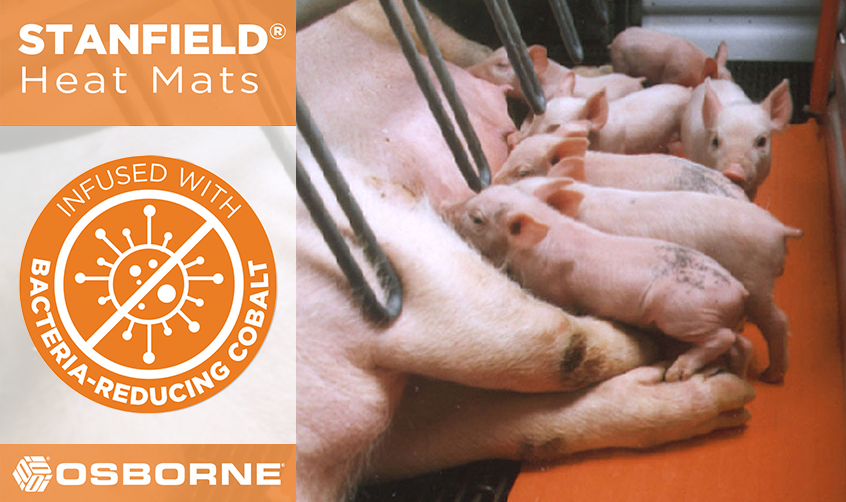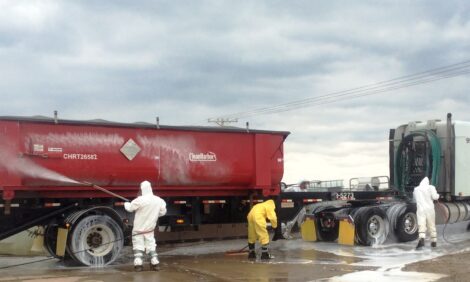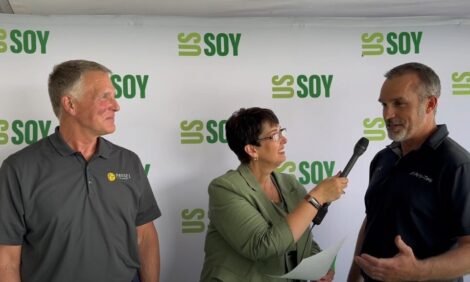



The great crate debate - are there other options at farrowing?
By Jane Jordan, ThePigSite Editor. Welfare is now a key component of EU pig production and as a consequence the systems used to rear pigs are continually under review. The farrowing crate is a contentious tool when it comes to welfare, but few systems can match its success in terms of reliability, efficiency and to some extent producer peace of mind when taking care of young piglets.
However, conscious of consumer attitudes - and always eager to explore more lucrative options - the innovative Danes are striving to find viable alternatives. Researchers at Denmark's Aarhus and Copenhagen Universities and the Agricultural Research Centre at Foulum, have been investigating free-farrowing pens since the early 1990s.
The research, part funded by the Danish Meat Association, is enabling science to understand sow behaviour at farrowing and to develop systems that could be practical, and profitable, at commercial level.
"Our industry wants to be ahead of any possible legislation that may be put forward in the future. Rather we act now to find suitable alternatives, than wait for rules to be imposed," says Dr Lene Pedersen, one of the researchers.
The project is also helping the pig sector assess and improve current innovations - it's providing a good defence for the crate, which remains the most efficient system in terms of piglet survival rates, welfare and sow performance.

The findings show that loose farrowing pens are viable if they are designed and managed carefully. There are benefits to sow health and welfare - for example sows display fewer shoulder sores and also appear calmer at farrowing and during lactation. Piglet mortality rates can be minimised if pens are structured to encourage specific lying behaviour and escape routes for piglets. And, as with all production systems, performance is markedly better when high levels of stockmanship are implemented.
Loose objectives
The Danish Government, in line with EU law, has now outlawed stalls and tethers for gestating sows. Confinement is only permitted for a short period post service. However, many Danish herds, particularly those supplying the UK market, have been using loose-housing systems for more than 10 years. The switch has not dented performance and Danish herds continue to be top of the table for production efficiency - and predictions expect this to continue*.
| Productivity | 2006 | 2016* |
|---|---|---|
| Sows | ||
| Live born piglets per litter, no. | 13,3 | 15,5 |
| Weaned per sow per year, no. | 25,6 | 28,2 |
| Piglet mortality, lactating period, per cent | 14,2 | 14,0 |
| Age, 30 kg | 85 | 81 |
| Slaughter pigs | ||
| Age at 82 kg slaughter weight, days | 175 | 162 |
| FEs per kg weight gain: 30-106 kg | 2,88 | 2,80 |
| Meat per cent | 60 | 60 |
| Mortality rate, 30-106 kg, per cent Slaughter pigs per sow per year |
3,8 23,5 |
2,0 27,0 |
However, scientists are intrigued as to how sows' that are predominantly 'free' for most of their lives adjust to confinement during farrowing and lactation.
Behaviour studies by Dr Lene Pedersen show that sows which are introduced to the farrowing crate late in gestation and close to parturition, have a higher number of still births. Gilts that are introduced to the crate the day before farrowing also tend to have prolonged births, more farrowing difficulties and more still born piglets. These animals also suffered higher neo-natal mortality rates.
"Hypoxia [oxygen deprivation] during the birth process is the main reason for still births. It's also attributable to other neo-natal mortalities such as hypothermia, starvation and crushing," says Dr Pedersen. Piglets that undergo a protracted birth tend to be weaker and less vigorous once they are born. The consequence is that these neonates are more susceptible to chilling and overlay.
Litter issues

Dr Pedersen says that with increasing litter size, this becomes a greater issue as the bigger the litter is; the longer birth process, and therefore the greater risk of hypoxia.
She says that some stress is inevitable when moving heavily pregnant sows into farrowing crates. However, her work clearly demonstrates that it is better to move them into crates as early as possible - at least five days before they are due to farrow.
"Our studies confirm that it takes sows between three and five days to settle down after they are moved into farrowing pens. And the nearer they are to their farrowing date, then the more difficulties they seem to encounter at farrowing," says Dr Pedersen.
She believes that the stress induced by moving is compounded by the stress of farrowing and this appears to have a detrimental effect on piglet survival.
Investigations with loose farrowing systems reveal similar problems, although the sows ability to 'nest' does appear to ease the stress of moving. In most cases, they seem to accept their new surroundings more quickly and are calmer than their confined counterparts.
Vivi Aarestrup Moustsen, a scientist with DMA's Danish Pig Production sector, has been investigating farrowing systems since 2001. She works closely with producers, researchers and the supply trade. Her studies show that sows which are managed in loose farrowing pens display significantly different behaviour than those managed in crates.
"Unlike the crate, loose systems have no effect on maternal behaviour and sows do not display the unsettledness seen in the confined systems," she explained. And, when compared with sows that farrowed in crates, these sows had much easier births with fewer still born piglets.
Dr Moustsen believed that a key reason for the improvement was the fact that loose-farrow sows did not experiences a complete change of environment - from freedom to confinement. Although there was some stress involved, it was to a lesser degree, and the sows were also able to express their natural instincts at a critical period (nest building, rooting etc). They also appeared more relaxed, They lay still once they began to farrow, and did so for up to 20 hours after the first piglet was born, which enabled the young to suckle and reduced the risk of overlays.

Few developments
Approximately 70 per cent of Danish sows are now loose-housed and there has been a raft of technological developments and innovations in this area in recent years. However, there have been few developments related to farrowing or lactating sows, with only minor changes seen to pen/crate design. "There are concerns here because sows and litters are increasing in size. We need to provide accommodation that enables the sows to nurse her young successfully without compromising welfare for her or her piglets. We also need the best facilities for the stockman to 'nurse' the sow effectively during this critical period, too," said Dr Moustsen. Nesting material and environmental enrichment are key elements of a farrowing system, and bedding material is a legal requirement. Also, solid floors assist sow comfort, although most commercial systems prefer to use slats as they are more hygienic. Pen and crate dimensions are under review because many of the systems installed on Danish farms are too small to accommodate modern genotypes and their increasing litter numbers.

Dr Moustsen said that sows are now 20 per cent heavier and 10 per cent longer than they were 10 years ago and litter size is up around three piglets to a 14.9. Weaning age has also increased and so litter weight and piglet sizes are far greater during lactation. On many farms pen sizes do need to be increased to accommodate this 'higher' stocking rate.
These issues, and the negative opinions that some retailers/consumers have about farrowing crates are fuelling the debate about crates and Dr Moustsen says change is inevitable. However, the solution is by no means simple or within reach just yet. Piglet mortality, hygiene, staff safety and labour resources must also be part of the equation. Loose farrowing systems must be workable, practical and economically viable and farmers must have the assurance that they will perform as well, if not better, than crates if they are going to become a viable alternative.
Pen design and practicalities

Sow welfare is not the sole focus with a free-farrowing system says Dr Moustsen. Other areas need careful consideration such as piglet welfare, ease of management and stockman access and safety. Danish Pig Production investigations are currently testing a number of pen designs to establish which systems best suit all three parties - the sow, the piglets and the staff.
Preliminary findings show that in all designs piglets need an escape route and a warm, creep area away from the sow.
Studies also show us that sow behaviour is influenced by pen layout and lying behaviour can be manipulated by placing rails or obstacles in certain positions that mean the sow is 'persuaded' to lie in a particular place or direction.
Researchers have also found that angled walls, which prevent sows from lying flush against the wall, are beneficial in preventing piglet overlays (see diagram). Wall bars and centralised creep boxes also work well.

However, the biggest influence in the success of loose systems is the stockman. Positive human interaction is vitally important, especially before sows farrow. It helps to build confidence, in both the animals and the staff, and researchers have found that any interventions required at farrowing or later when the piglets need to be treated or fostered, is accepted by the sow and much easier to negotiate. Loose farrowing pens do, however, need to offer some form of sow restraint and or easy 'escape routes' because staff safety is paramount.
Dr Moustsen says that her studies show that loose farrowing does have potential. "Our research is demonstrating what works best. The next step is to evaluate the systems in private herds at a more commercial level," said Dr Moustsen.
She says that there is growing interest in these systems and the pig industry must acknowledge that some legislators and consumers may demand producers use free-farrowing regimes in the future. However, for the moment, there are too many unresolved issues surrounding piglet mortality, pen design, and hygiene and operator safety to make them a truly viable option for most commercial herds.
August 2007








